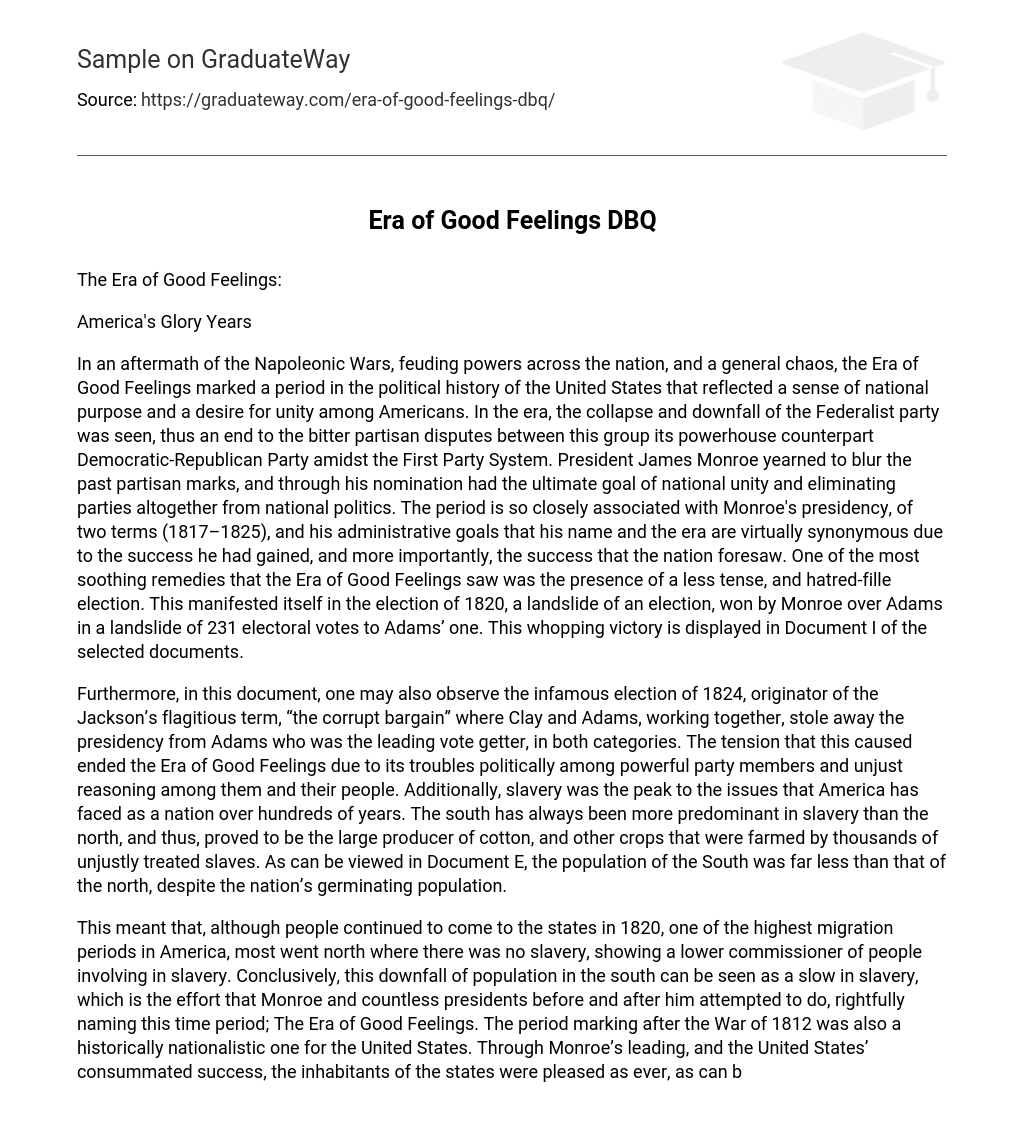The Era of Good Feelings:
During America’s glory years
In the aftermath of the Napoleonic Wars, the United States experienced feuding powers, national chaos, and political disputes. However, the Era of Good Feelings emerged as a period that aimed to establish national unity and purpose among Americans. During this era, the Federalist party collapsed, ending the bitter partisan conflicts with the Democratic-Republican Party. President James Monroe played a crucial role in promoting national unity and eliminating parties from politics. His two-term presidency from 1817-1825 is closely associated with this period, and his success was viewed as pivotal for the nation’s future. Notably, the Era of Good Feelings witnessed a less intense and divisive election in 1820. This election resulted in a landslide victory for Monroe with 231 electoral votes compared to Adams’ one vote, as depicted in Document I of the selected documents.
Moreover, this document highlights the notorious election of 1824, which gave rise to Jackson’s widely known phrase “the corrupt bargain.” In this election, Clay and Adams formed an alliance to wrest the presidency from Adams, who had garnered the majority of votes in both categories. This incident caused tension that ultimately brought an end to the Era of Good Feelings. The unjust rationale and political troubles among influential party members were accountable for this outcome. Additionally, slavery has been an enduring problem that has plagued America for centuries. The South has consistently held a stronger presence of slavery compared to the North, resulting in its substantial contribution as a major producer of cotton and other crops cultivated by numerous mistreated slaves. As evidenced in Document E, despite the nation’s increasing population, the South had a significantly smaller population than the North.
During the peak migration period in America in 1820, it can be observed that most people chose to settle in the northern states where slavery was non-existent. This decline in population in the southern states can be seen as a significant step towards ending slavery, which was a goal pursued by President Monroe and his predecessors. Consequently, this time period came to be known as the Era of Good Feelings.
Notably, following the War of 1812, the United States experienced a surge of nationalism. Under Monroe’s leadership and with the nation’s consolidated success, the people of the United States were highly satisfied, as evident in John Krimmel’s painting from July Fourth, 1819. The artwork portrays a diverse group of individuals, spanning different age groups, participating in annual patriotic celebrations led by James Monroe. This display of patriotism truly reflects the strong sense of nationalism felt by American citizens during this era, further justifying its designation as the Era of Good Feelings.
During this period, Monroe’s dedication to preserving religious freedom for his people was a crucial aspect. In Document H (not sure what document is being referred to), John Quincy Adams acknowledges that this presents an opportune moment for the United States to oppose the Holy Alliance while rejecting Great Britain’s proposal.Despite their rivalry in elections, Adams highlights the mutual respect between them. In 1823, Adams wrote about Monroe’s presidency in his diary and how he was strengthening the United States to increase its power, contributing to the appropriate and well-deserved label given to this era (Document A). Calhoun addresses Congress in Document B, expressing concerns about potential disunion caused by population growth in the states. He suggests maintaining interconnectedness through a flawless system of railways and canals and urges conquering space. Monroe ensured that the states were well-organized in terms of infrastructure, federal laws, and overall administration. Despite doubts and questioning, Monroe’s leadership effectively upheld order and prosperity in the states, resulting in this era being called “The Era of Good Feelings.” The United States faced turmoil before and during the War of 1812. During a time of intense political competition domestically and internationally, Monroe played a crucial role in establishing peace within the country. Through actions such as dismantling the Federalist Party, addressing population growth issues, and managing relations with Britain, Monroe successfully unified the nation during its most prosperous phase known as “The Era of Good Feelings.”





